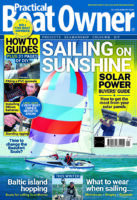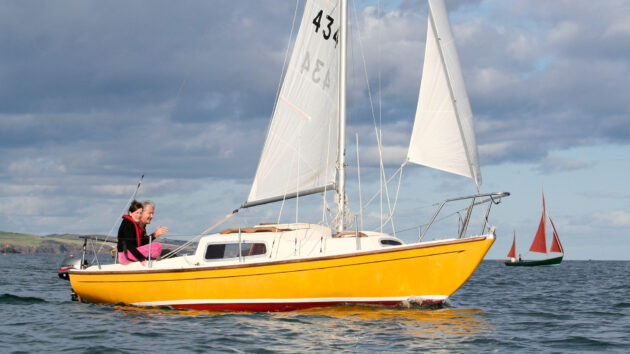In his latest used boat review, Clive Marsh compares two of the best small sailboats for sale. The Silhouette Mk3 and the Corribee Mk2 are classic pocket cruisers, both designed by Robert Tucker.
Among my favourite low-cost pocket cruiser sailboats are the Robert Tucker-designed Silhouette Mk3 and the Corribee Mk2, both bilge keelers.
All yachts designed by Robert Tucker are good looking and I have owned three of them, two built by Hurley Marine and one by Newbridge, both excellent boat builders. These little yachts are now classics, and I’d be pleased to own one again should the opportunity arise.
The bilge keel versions are ideal for coastal and estuary sailing, although some have been much farther afield.

Front view of Clive’s Silhouette Mk3. Photo: Clive Marsh.
Pretty pocket cruisers
It was Dame Ellen MacArthur who cut her teeth, when a youngster, sailing a fin-keeled Corribee all around the coast of Britain. When Dame Ellen first saw her Corribee-to-be she said it was ‘love at first sight’.
And that is just how I felt when I saw my Corribee – she was just too pretty for a compulsive buyer like me to miss. The same goes for the Silhouette, they are very pretty boats. Both were boats that I bought at first sight.

Tired crew and Clive’s Corribee Mk2 at her berth in Emsworth. Photo: Clive Marsh.
Ballasted Boats
Before you rush out to buy one, just remember that, like most ballasted boats of that era, both might benefit from improved semi-watertight compartments and lockers. From my own experience, this would give you more time in the unlikely event of a holing below the waterline.
I modify most of my ballasted boats in this way. Just a personal preference.
I also add buoyancy. How to calculate how much buoyancy you need and where to place it is a problem for a naval architect and boatbuilder to resolve properly. It is really a question of risk assessment and where you intend to take the boat.
The main question for me is, if I were to buy another, would it be a Silhouette or a Corribee Mk2? Both models are regularly on the market at what seem like bargain prices.
Living space in a pocket cruiser

Clive’s Corribee Mk2 on her pontoon berth. Room enough for four. Photo: Clive Marsh.
The Corribee Mk2 is longer and has a bit more space and headroom inside. She looks more like a mini yacht than a pocket cruiser.
The Silhouette is more of a two-person boat ideal for a couple, but a bit cramped even with little kids. I normally sail alone now that the kids have flown and Mrs Marsh likes a bigger boat, something around 40ft.
So, the Silhouette is ideal for me and far better than having to put the tent up overnight, as I would have to do on a trailer-sailer.

A Corribee similar to Clive Marsh’s Petite Beure before the repaint to blue and name change to Tui.
Pocket cruisers: mooring considerations
Talking of trailer-sailers, Silhouettes and Corribees often come with a trailer, but they are not what I would call easy trailer-sailers. They are heavy, and launch/recovery is a significant operation that will require careful planning and execution.
These boats are usually kept on a drying mooring, but having a trailer and a suitable vehicle does allow a certain freedom when you want the boat out of the water for antifouling or overwintering.
The Corribee has a very elegant transom and long overhang. It lifts nicely to a following sea. This is great if you have a Corribee with a neat little inboard engine fitted – better distribution of weight, and the prop mainly stays in the water.
However, most Corribees, including mine, use an outboard. This is a real pain because it’s difficult to mount the motor over the pushpit, it is hard to reach controls unless a Morse control is fitted and it is prone for the prop to leave the water.
In fact, it was this feature that attracted me to the Silhouette Mk3. She has a marvellous semi-outboard well cut out of her transom. Her outboard is therefore semi-inboard, less prone to cavitation, easy to reach and raise, does not place too much weight aft and is less vulnerable when moored. Unless a Corribee has an inboard (rare), I’d go for a Silhouette Mk3 with its neat outboard well.
Sea kindly used boats
As for performance, there is very little to choose between these pocket cruisers. Both are excellent sea boats under sail.

Photo: Clive Marsh.
The Corribee is a tad faster (half a knot) but when motoring or motor-sailing, the Silhouette is better. This minor speed difference is of little consequence when using the boats for day sailing.
One great advantage of these bilge keel boats is their ability to take the level ground and avoid more expensive pontoon or swing moorings. I also like a boat that takes the ground so that I can beach for a picnic ashore without the need for a tender, and I like to be able to inspect the hull to apply antifouling.

Photo: Clive Marsh.
However, if you take a pontoon mooring, then the Corribee will cost more because of its length, as indicated already. Generally, the shorter the boat, the lower the mooring fee and harbour dues on any type of mooring. If you go for a fin-keel Corribee or a fin-keel Silhouette (there are some), then you might need to use a floating pontoon mooring or swing mooring unless you can find a suitable wall or deep soft mud such as is available at Rye and other similar places.
Both boats have their rudders underneath the hull (not transom hung), and this has certain advantages and significant disadvantages. I like under hull rudders to be protected and more robust by incorporating a skeg. Most of the Silhouette Mk3s I have seen have a skeg, but not so many Corribees have one.

Photo: Clive Marsh.
This is something you might want to consider. Without a skeg, it’s easier for the rudder stock to get bent. This has happened to me with a spade-type rudder. However, on bilge keel yachts, spade rudders are less vulnerable.
Both boats are attractive and well built. Which one to buy will depend upon the features that meet your needs at the time. These needs change every few years. For me, as a mainly solo sailor, I’d go for the tough little Silhouette with her serpentine curves. But whichever boat you buy, you won’t be disappointed.
For more information, search the Silhouette Owner’s Association and the Corribee Owners Association and their websites. There’s plenty of advice and details of events etc.
Silhouette vs Corribee: Comparison of features
Please note: These are for guidance; many boats have various modifications.

Corribee Mk2 used boat review: Robert Tucker design has stood the test of time
I found my Robert Tucker-designed Corribee Mk2 at Tarquin’s Boat Yard in Emsworth which is now known as Emsworth Marina.…
Pocket cruisers: the best boats between 17-20ft
Whether you’re moving on from dinghies, or downsizing to a boat that’s fun without being a financial millstone, here’s a…
Westerly Cirrus and Tiger: two excellent fast cruisers that can now be bought for the price of a decent sofa!
Clive Marsh shares why those looking for a smaller boat should consider the Westerly Cirrus and Tiger
Silhouette 17 used boat review: This pocket cruiser can be a real bargain
Robert Tucker designed many pocket cruisers that were built mainly in the 1950s to 1970s. I have owned three of…
Want to read more articles like this?

A subscription to Practical Boat Owner magazine costs around 40% less than the cover price.
Print and digital editions are available through Magazines Direct – where you can also find the latest deals.
PBO is packed with information to help you get the most from boat ownership – whether sail or power.
-
-
-
- Take your DIY skills to the next level with trusted advice on boat maintenance and repairs
- Impartial, in-depth gear reviews
- Practical cruising tips for making the most of your time afloat
-
-
Follow us on Facebook, Instagram, TikTok and Twitter








